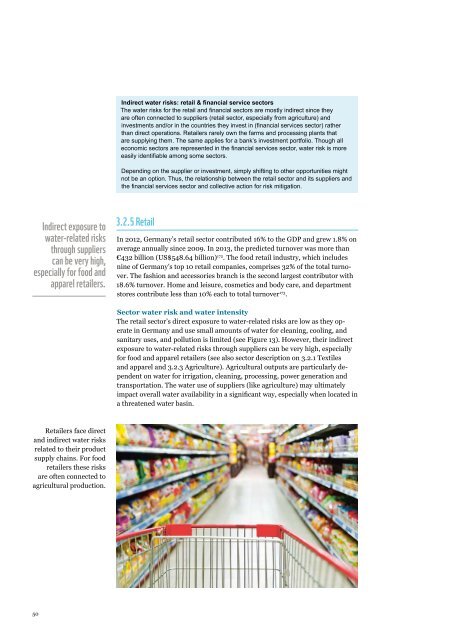YtDl2r
YtDl2r
YtDl2r
Create successful ePaper yourself
Turn your PDF publications into a flip-book with our unique Google optimized e-Paper software.
Indirect water risks: retail & financial service sectors<br />
The water risks for the retail and financial sectors are mostly indirect since they<br />
are often connected to suppliers (retail sector, especially from agriculture) and<br />
investments and/or in the countries they invest in (financial services sector) rather<br />
than direct operations. Retailers rarely own the farms and processing plants that<br />
are supplying them. The same applies for a bank’s investment portfolio. Though all<br />
economic sectors are represented in the financial services sector, water risk is more<br />
easily identifiable among some sectors.<br />
Depending on the supplier or investment, simply shifting to other opportunities might<br />
not be an option. Thus, the relationship between the retail sector and its suppliers and<br />
the financial services sector and collective action for risk mitigation.<br />
Indirect exposure to<br />
water-related risks<br />
through suppliers<br />
can be very high,<br />
especially for food and<br />
apparel retailers.<br />
3.2.5 Retail<br />
In 2012, Germany’s retail sector contributed 16% to the GDP and grew 1.8% on<br />
average annually since 2009. In 2013, the predicted turnover was more than<br />
€432 billion (US$548.64 billion) 172 . The food retail industry, which includes<br />
nine of Germany’s top 10 retail companies, comprises 32% of the total turnover.<br />
The fashion and accessories branch is the second largest contributor with<br />
18.6% turnover. Home and leisure, cosmetics and body care, and department<br />
stores contribute less than 10% each to total turnover 173 .<br />
Sector water risk and water intensity<br />
The retail sector’s direct exposure to water-related risks are low as they operate<br />
in Germany and use small amounts of water for cleaning, cooling, and<br />
sanitary uses, and pollution is limited (see Figure 13). However, their indirect<br />
exposure to water-related risks through suppliers can be very high, especially<br />
for food and apparel retailers (see also sector description on 3.2.1 Textiles<br />
and apparel and 3.2.3 Agriculture). Agricultural outputs are particularly dependent<br />
on water for irrigation, cleaning, processing, power generation and<br />
transportation. The water use of suppliers (like agriculture) may ultimately<br />
impact overall water availability in a significant way, especially when located in<br />
a threatened water basin.<br />
Retailers face direct<br />
and indirect water risks<br />
related to their product<br />
supply chains. For food<br />
retailers these risks<br />
are often connected to<br />
agricultural production.<br />
50


